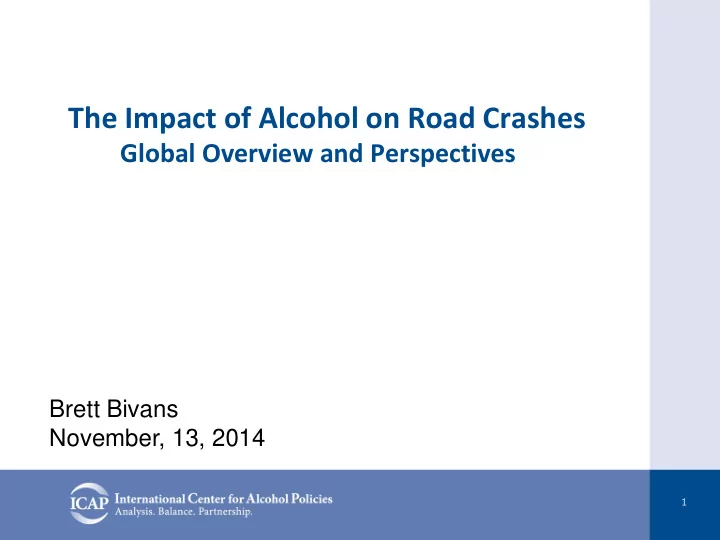

The Impact of Alcohol on Road Crashes Global Overview and Perspectives Brett Bivans November, 13, 2014 1
Road Traffic Crashes: A Global Epidemic (1) • Worldwide 1.2 million people die each year in road traffic crashes • 20-50 million people injured annually • In 2012, Road crashes was the 9 th leading cause of death in the world • Road injury is forecast to be the 7 th leading cause of death globally by 2030 • Road traffic crashes are the leading cause of death for people aged 15 – 29 worldwide 2
Road Traffic Crashes: A Global Epidemic (2) • 92% of road traffic deaths occur in low and middle income countries 3
Road Traffic Crashes: A Global Epidemic (3) • Estimated cost - $518 billion annually • $65 billion in low/middle income countries • Costs estimated at 1% - 1.5% GNP (low/middle income countries) • Alcohol a factor in 33%-69% of fatal crashes (low/middle income countries) • In many low and middle income countries data on alcohol-related road traffic deaths is unavailable or unreliable • Differences between countries: • Legal limit for drinking and driving • Definition of what constitutes drinking and driving 4
Drink Driving and Crashes • Crash risk increases with increasing alcohol consumption • Single vehicle crashes • Run-off-road single vehicle crashes • High speed crashes (especially rural) • Hit roadside object crashes • High proportion of nighttime crashes • High proportion of weekend crashes 5
Alcohol Effects on Driving There is an impact on: reaction times driver vigilance driver visual acuity steering efficiency risk of complications in injury rehabilitation 6
Demographic Characteristics of Drink Drivers • Males, 18-24 years old • From low socio-economic groups • Single or divorced • In blue collar occupations • Low education and literacy levels • Low self-esteem 7
Solutions • Highly motorized countries have been able to reduce drink driving • Examples include Australia, and more recently France • Successful programs cannot always be translated unchanged to other countries because: • Cultural beliefs differ from country to country • Traffic mix is often very different • Style and quality of road networks can differ • Education levels vary and communication modes differ. • But key principles of successful programs can be applied 8
Key Principles of Successful Programs • Strong political commitment to prevent drink driving • Clearly defined legislation for BAC level and penalties for offences • Implementing “good practice” • Strong and well publicized enforcement campaigns • Public education to change attitudes toward drinking and driving • Strict and swift enforced penalties for offenders 9
Global Actions on Harmful Drinking Initiatives Projects in six countries China, Colombia, Mexico, Nigeria, Russia and Vietnam Focus on: Capacity Building Local Projects • Public education and awareness campaigns, enhanced enforcement campaigns, mass media Evaluation 10
Shoom Shufair Campaign – Ethiopia Shoom Shufair is an example of how private sector can help reduce drinking and driving. Project Goals: Raise awareness around not drink-driving Increased intention to use designated driver (shoom shufair) Partnerships & collaboration to address the issue 11
Partnerships for Shooom Shufair Broad range of partners involved in the project: • Government (Federal Roads Transport Authority) • Private Sector • Hospitality Industry (Radisson Blu) • Vehicle Rentals/Tour Operators • Insurance (Nyala Insurance) • Media (AfroFM) 12
Summary • Alcohol impairs driving performance • Alcohol involved crashes are a high proportion of all severe crashes in many countries • Young, inexperienced males are most at risk • Typical alcohol involved crash types are known • There are some key principles of successful programs and ‘good practice’ interventions proven to reduce alcohol related crashes 13
Recommend
More recommend